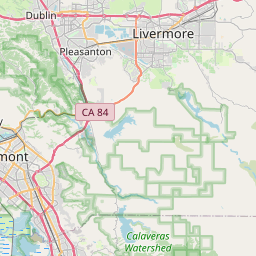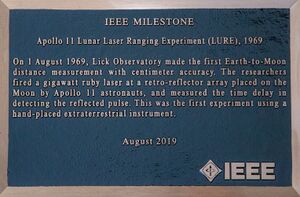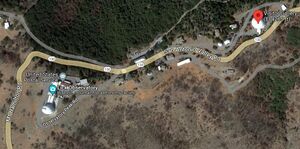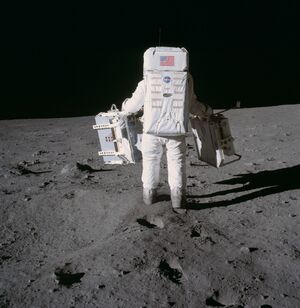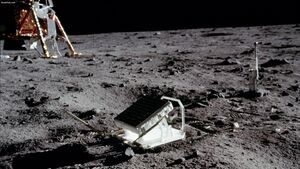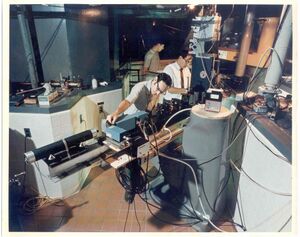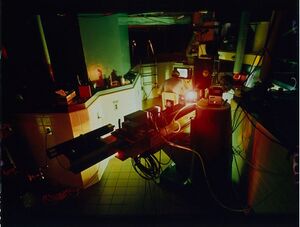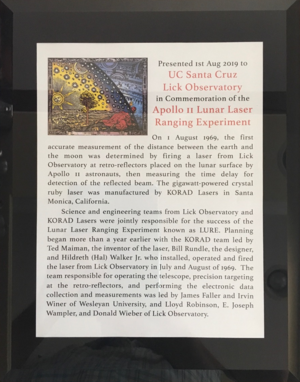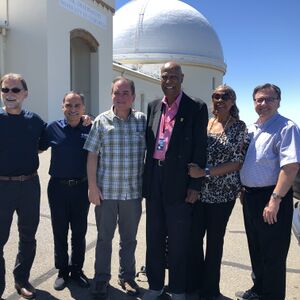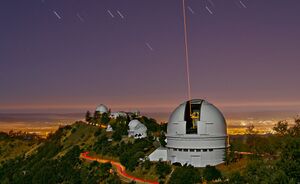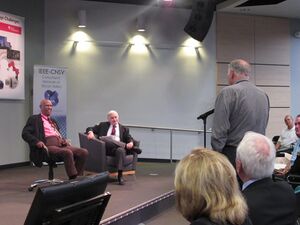Milestones:Apollo 11 Lunar Laser Ranging Experiment (LURE), 1969
- Date Dedicated
- 2019/08/01
- Dedication #
- 197
- Location
- Lick Observatory, San Jose, CA
- IEEE Regions
- 6
- IEEE sections
- Santa Clara Valley
- Achievement date range
- 1969

Title
Apollo 11 Lunar Laser Ranging Experiment (LURE), 1969
Citation
On 1 August 1969, Lick Observatory made the first Earth-to-Moon distance measurement with centimeter accuracy. The researchers fired a gigawatt ruby laser at a retro-reflector array placed on the Moon by Apollo 11 astronauts, and measured the time delay in detecting the reflected pulse. This was the first experiment using a hand-placed extraterrestrial instrument.
Street address(es) and GPS coordinates of the Milestone Plaque Sites
- Site 1: the Shane 120-inch Reflector Telescope Dome on Mt. Hamilton above San Jose, CA, at Lick Observatory (one of the Univ. of California Observatories) 37.34344, -121.63720
- Site 2: on Santa Monica city property adjacent to Water Garden (at approx. 2450 Colorado Ave., Santa Monica, CA), a major new office and shopping complex whose tenants include Amazon Studios and CBS Global Distribution Group, and also close to a station of the Los Angeles Metro Rail light rail system, 34.0292694,-118.4743055
Details of the physical location of the plaque
- Site 1: on the wall of the Visitor Gallery of the Shane 120-inch Reflector Telescope Dome building
- Site 2: on an outdoor pedestal by Colorado Ave. on Santa Monica city property adjacent to the Water Garden complex.
How the plaque site is protected/secured
- Site 1: the Shane 120-inch Reflector Telescope Dome building is open to the public weekdays and weekends from 10am-5pm
- Site 2: the outdoor pedestal containing the plaque by Colorado Ave. resides on Santa Monica city property, which has has 24-hour camera security like the adjacent Water Garden complex.
Historical significance of the work
"The scientific and engineering achievement of LURE—which aimed at using lasers to precisely measure the distance between the Earth and the moon—held huge potential strategic value, both military and commercial." [Ref1: Optics & Photonics News] at p. 45.
"The experiment had its origin in discussions among members of the experimental gravitational research group at Princeton University (HOFFMAN et al., 1960). Because of the many areas of science and technology involved in the experiment, a group was organized to carry it out." [Ref2: Apollo 11 Conference] at p. 1948.
"The Apollo 11 Laser Ranging Retro-Reflector (LRRR) was designed by a team of scientists and engineers to serve as a reference point on the lunar surface to be used in continued monitoring of the point-to-point distances between it and stations on earth by the technique of short-pulse laser ranging." [Ref3: Science Magazine 1970] at p. 368.
At Lick Observatory's Shane 120-inch (3 meter) Reflector Telescope Dome on Mt. Hamilton , the "plan was to use the 3m reflector to fire brief (some nanoseconds in length) but intense pulses of light at a reflector placed on the moon, then precisely time the arrival of the return pulse back at the telescope about 2.5 seconds later. Each pulse would allow measurement of the distance to the moon to within a few meters. Repeated pulses would allow increased precision of measurement, and were expected to result in a night-to-night distance to the moon accurate to a few centimeters. The primary goal was to investigate fundamental aspects of gravitation." [Ref4: Lick Recollections 2007]
Hal Walker, Jr., "a former U.S. Navy electrician’s mate, was the key man on station at Lick Observatory in California manning his team’s 1.2-GW ruby-crystal laser. On [1 August 1969], he fired KORAD’s laser at the moon and received a successful ranging signal—thus beating the Soviets to the punch, and earning Walker a place in engineering history." [Ref1: Optics & Photonics News] at p. 42.
The weapons-grade ruby-crystal KORAD laser system used in the Apollo 11 Lunar Ranging Experiment (LURE) that was the first laser to successfully complete the experiment was invented, designed, manufactured, and tested at KORAD Lasers in Santa Monica, Calif. The laser was then transported to Lick Observatory in preparation for the Apollo 11 mission.
The Apollo 11 astronauts placed the LRRR array about 20 feet from the Lunar Module (LM) within the Tranquility Base [Ref5: NASA Apollo 11 Report] at pp. 27-28, 51-52, 89 and 188. "Once the astronauts had left the lunar surface, the LURE array was cleared for targeting by Walker’s team of scientists and engineers and their gigawatt laser back on Earth. Four U.S.-based teams equipped with high-powered lasers then began a painstaking search for the minuscule retroreflector target nearly a quarter-million miles away—the array’s exact coordinates in the Sea of Tranquility being unknown. The teams, each armed with a laser system, were stationed at McDonald Observatory in Texas, Mount Haleakala Observatory in Hawaii, and two laser teams at Lick Observatory in California. Walker’s KORAD team was at Lick, along with a competing laser-ranging team from Spacerays." [Ref1: Optics & Photonics News] at p. 46.
"The Lick Observatory participated in the acquisition phase of the experiment to increase the probability of getting early returns. The weather and seeing are generally excellent there in the summer. Laser ranging activities ceased at Lick in August. In October a custom-built four-stage ruby laser, made by Korad, was installed at the McDonald Observatory." [Ref2: Apollo 11 Conference] at p. 1950.
By the time the laser beam reached the moon, it is estimated to have been spread across an area in excess of 2 km in diameter. Thus the ability to hit the targeted Array was essential to getting an appropriate recognizable signal from the return photons. Filters were used to remove ambient light and to capture the red photons at 6943 Angstroms, and photo-multipliers were used to count photo-electrons through a time-delayed gate that collected and measured the return signal strength.
During the setup and target acquisition phase of the LURE, some of the components of the KORAD laser had exploded due to the high voltage and high power discharges, potentially terminating the KORAD ranging. This kind of failure was in fact the fate of a competing laser system manufactured by SpaceRays that has also been operating at Lick Observatory. Hal Walker, Jr. of the KORAD team drove from Lick Observatory to Santa Monica (a trek of over 350 miles) to pick up replacement parts, and returned with them to Lick Observatory.
The KORAD team at Lick Observatory went on to complete 169 successful laser shots at the target which each measured the round trip time to the moon. "Acquisition measurements of the round-trip travel time of light, from the McDonald Observatory to the Laser Ranging Retro-Reflector deployed on the moon by the Apollo 11 astronauts, were made on 20 August and on 3, 4, and 22 September 1969. The uncertainty in the round-trip travel time was +/- 15 nanoseconds, with the pulsed ruby laser and timing system used for the acquisition." [Ref3: Science Magazine 1970] at p. 368.
" 'The Russians knew very accurately the distance between Russian cities and between cities within the United States, but they didn't know the distance between the U.S. and Russia,' explained Joe Wampler, professor emeritus of astronomy, who coordinated the experiment for the observatory. 'Having an accurate measure of the distance to the moon at a moment in time would've given them that information.' " " 'We were measuring so accurately that we could see the distance to the moon change within minutes.' " [Ref6: Lick Recollections 2009]
"Although the Earth and moon orbit around one another, the gravitational effects of the moon on the Earth aren't simple, explained Miller. By following the moon closely, Lick researchers propelled scientific understanding of geologic processes on earth, including continental drift. 'At the time, a lot of people still didn't believe in continental drift,' noted Wampler. The experiment contributed a grand new chapter to a story that goes back thousands of years, noted Wampler. 'The moon has been used for a very long time in cosmology,' he said. 'The Greeks in 300 B.C. knew the distance to the moon with about 5 percent accuracy.' The moon figured prominently in the development of Isaac Newton's theory of gravity, as well as in Einstein's theories about cosmology." [Ref6: Lick Recollections 2009]
The NASA Apollo 11 Preliminary Science Report of October 1969 is an important historical record with its detailed description of this experiment and its earliest results, numerous photographs taken by the Apollo 11 astronauts, a diagram showing placement of the retro-reflector array within Tranquility Base, and information about the other scientific experiments undertaken by the Apollo 11 crew. This document shows that the mission's primary scientific objectives included the study of gravitation and relativity, and the physics and dynamics of the Earth and Moon systems. [Ref5: NASA Apollo 11 Report] at pp. 3-4, 27-28, 51-52, 89, 163-182 and 188.
The Apollo 14 and Apollo 15 missions each included placement of an LRRR array on the moon in 1971, and the USSR also placed two of its own LRRR arrays in 1970 and 1973. Laser ranging experiments continue to this day, making them the only continuing active science projects from that era.
Obstacles (technical, political, geographic) that needed to be overcome
Technical Obstacle #1: Sending a manned mission to the moon and placing a retro-reflector on the lunar surface. This was first accomplished by the Apollo 11 astronauts positioning a retro-reflector on 21 July 1969, shortly before the LM left the lunar surface. In late 1970, the Soviet Union's Luna 17 spacecraft carried the second retro-reflector to the moon along with Lunokhod 1 (Луноход, moon walker in Russian), an unmanned lunar rover. Lunokhod 1 was the first remote-controlled robot "rover" to freely move across the surface of an astronomical object beyond the Earth, and the Soviet retro-reflector was used to determine its location.
Technical Obstacle #2 (building and operating a gigawatt-powered laser system based on a weapons-grade ruby-crystal laser), Technical Obstacle #3 (finding a tiny target on the lunar surface) and Technical Obstacle #4 (detecting between 1 and about 10 reflected photons): "Two contractors were chosen to create the high-powered laser systems that would serve as the Earth-bound component of the LURE project: Spacerays Corporation and KORAD Laser Systems." "Each KORAD laser system had a unique set of challenges due to the developmental nature of the technology, so it was not a simple matter of firing at will to hit the retroreflector on the moon." "In the end, success depended less on chance than on technological readiness. Some teams encountered catastrophic equipment failures due to the high-powered nanosecond pulses, which literally broke down the molecular structure of the air around the equipment, complete with thunderous bangs and fried electronics. System-design thresholds and even sabotage were also claimed as sources of failure. In other cases, with beam-widths at the surface of the moon dispersed as wide as 7 km, there was just not enough transmitted energy to produce a recognizable signal from the few photons that returned to the Earth." "Success came at last to Walker and his team in the early morning hours of 1 August 1969. A few days earlier, Walker’s team’s laser had experienced its own catastrophic failure and had to be replaced with a unit from KORAD’s labs in Santa Monica, 350 miles south of Lick Observatory. Hal himself raced down Mount Hamilton in a rented car to get to KORAD, pick up the replacement parts, then return to Lick and get the equipment installed and operational for the next round of shots." [Ref1: Optics & Photonics News] at pp. 45 and 46.
Political Obstacle: Finding the retro-reflector on the lunar surface before the Soviets did: "Four U.S.-based teams equipped with high-powered lasers then began a painstaking search for the minuscule retroreflector target nearly a quarter-million miles away—the array’s exact coordinates in the Sea of Tranquility being unknown. The teams, each armed with a laser system, were stationed at McDonald Observatory in Texas, Mount Haleakala Observatory in Hawaii, and two laser teams at Lick Observatory in California." "It soon became apparent to the U.S. scientists scrutinizing the Sea of Tranquility, however, that someone else on Earth was also firing ruby-red beams at the moon and attempting to hit the LURE array. Those rogue laser shots, it turned out, were from a team of Soviet scientists, who hoped to achieve an end run around the U.S. groups. There was, of course, no way to stop the Soviet team from trying—but as [Hal] Walker reports, the American teams were told in no uncertain terms by their NASA and DARPA sponsors, 'Don’t let the Soviets hit our mirrors!' The race was on between the lunar laser-ranging teams." [Ref1: Optics & Photonics News] at p. 46.
Features that set this work apart from similar achievements
An accurate measurement of the distance to the moon was not possible until a retro-reflector was placed on the lunar surface. The Apollo 11 astronauts first did this on 21 July 1969, and 1 August 1969 is the date of the first accurate measurement of the distance to the moon.
The reflector experiments were to be used for more than simply determining an accurate earth-moon distance, including permitting "precise measurements of the lunar orbital motion, lunar librations, the lunar radius, fluctuations in the earth's rotation rate, Chandler wobble of the earth's axis, intercontinental drift rate, and a possible secular change of the gravitational constant." "As a result, point-to-point measurements of the distance can now be made with an accuracy approaching 15 cm." [Ref7: Science Magazine 1969] at p. 100. "The Lunar Ranging Experiment is the responsibility of the LURE Group, which consists of C.O. Alley of the University of Maryland, P.L. Bender of the University of Colorado and the National Bureau of Standards, R.H. Dicke of Princeton University, J.E. Faller of Wesleyan University, W.M. Kaula of the University of California at Los Angeles, G.J.F. MacDonald of the University of California at Santa Barbara, J.D. Mulholland of the Jet Propulsion Laboratory, H.H. Plotkin of the Goddard Space Flight Center, and D.T. Wilkinson of Princeton University." [Ref7: Science Magazine 1969] at p. 102.
On the 35th anniversary of the Apollo 11 landing (20 July 2004), NASA noted that "A cutting-edge Apollo 11 science experiment left behind in the Sea of Tranquility is still running today." [Ref8-NASA-Apollo11-2004]
Significant references
- [Ref1: Optics & Photonics News]
- [Ref2: Apollo 11 Conference]
- [Ref3: Science Magazine 1970]
- [Ref4: Lick Recollections 2007]
- [Ref5: NASA Apollo 11 Report]
- [Ref6: Lick Recollections 2009]
- [Ref7: Science Magazine 1969]
- [Ref8-NASA-Apollo11-2004]
Supporting materials
- Apollo 11 Press Kit
- "The Lunar Laser Reflector": Scientific American story by James E. Faller and E. Joseph Wampler
- August 1, 2019 Evening Event Slides
- August 1, 2019 Evening Event Program Booklet
- Moon retroreflector proposal from late 1950s
- IEEE Spectrum story about LURE
- Lick Story about the LURE and IEEE Milestone (2019)
- Apollo 11 Lunar Science Conference Paper on LURE (1970)
- City of Santa Clara Proclamation for LURE
- Honoring the Legend of Hal Walker
Dedication Ceremony
Afternoon Program on 1 August 2019 (Milestone Plaque Dedication at Lick Observatory, overlooking Silicon Valley). Dedication of the LURE IEEE Milestone plaque in the Visitor Gallery of the Shane 120" Reflector Telescope. Included are stories from Hal Walker (who fired the laser), Remington Stone (who first directed the telescope at the moon), and others.
Evening Celebration
Evening Program on 1 August 2019 (at Texas Instruments, Santa Clara, CA): This is the complete evening program of LURE presentations and discussions. Included is SETI's Seth Shostak in conversation with Hal Walker about what it took to aim a laser at the moon and detect its reflection exactly 50 years earlier. Others on Hal's team provide commentary, including Joseph Wampler who worked with Hal Walker in this effort.
Map
